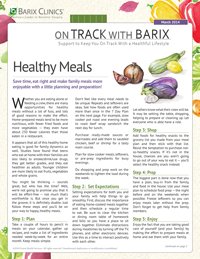On Track with Barix: Healthy Meals
Whether you are eating alone or feeding a crew, there are many opportunities for healthy meals without a lot of fuss, and lots of good reasons to make the effort. Home-prepared meals tend to be more nutritious, with fewer fried foods and more vegetables—they even have about 250 fewer calories than those eaten in a restaurant.
It appears that all of this healthy home eating is good for family dynamics as well. Studies have found that teens who eat at home with their families are less likely to smoke/drink/use drugs, they get better grades, and they eat healthier as adults. Younger children are more likely to eat fruits, vegetables and whole grains.
You might be thinking–sounds great, but who has the time? Well, we’re not going to promise you that it will be effort-free—not much that‘s worthwhile is. But once you get in the groove, it is definitely doable. Just follow these steps and you’ll be on your way to happy, healthy meals.
Step 1: Plan
Take a couple of hours to pencil in meals on your calendar, gather up recipes, and make a list of ingredients needed week-by-week for an entire month. Keep meals simple.
Don’t feel like every meal needs to be unique. Repeats and leftovers are okay. See how foods are often used more than once in the 7 Day Plan on the next page. For example, slow cooker pot roast one evening leads to roast beef wrap sandwich the next day for lunch.
Purchase ready-made sauces or marinades and add them to sautéed chicken, beef or shrimp for a tasty main course.
Plan for slow cooker meals, leftovers, or pre-prep ingredients for busy evenings.
Do shopping and prep work on the weekends to lighten the load during the week.
Step 2: Set Expectations
Setting expectations for both you and your family will help things to go smoothly. First, discuss the importance of eating home-cooked meals together and then schedule a regular time to eat. Be sure to clear the kitchen or dining room table of homework and bills so you have a place to sit down together. Eliminate distractions during mealtimes by turning off the TV, phones, and other electronic devices. Use this as a time to interact positively with each other.
Let others know what their roles will be. It may be setting the table, shopping, helping to prepare or cleaning up. Let everyone who is able have a role.
Step 3: Shop
Add foods for healthy snacks to the grocery list you made from your meal plan and then stick with that list. Resist the temptation to purchase not-so-healthy snacks. If it’s not in the house, chances are you aren’t going to go out of your way to eat it–you’ll select the healthy snack instead.
Step 4: Prep
The biggest part is done now that you have a plan, buy-in from the family, and food in the house. Use your meal plan to schedule food prep—the night before and on the weekends when possible. Freeze leftovers so you can enjoy meals later without the prep. Don’t forget to get help from family members.
Step 5: Enjoy
Enjoy the fact that you are taking good care of yourself (and your family) by making the effort to prepare meals at home and eat them with your family.


